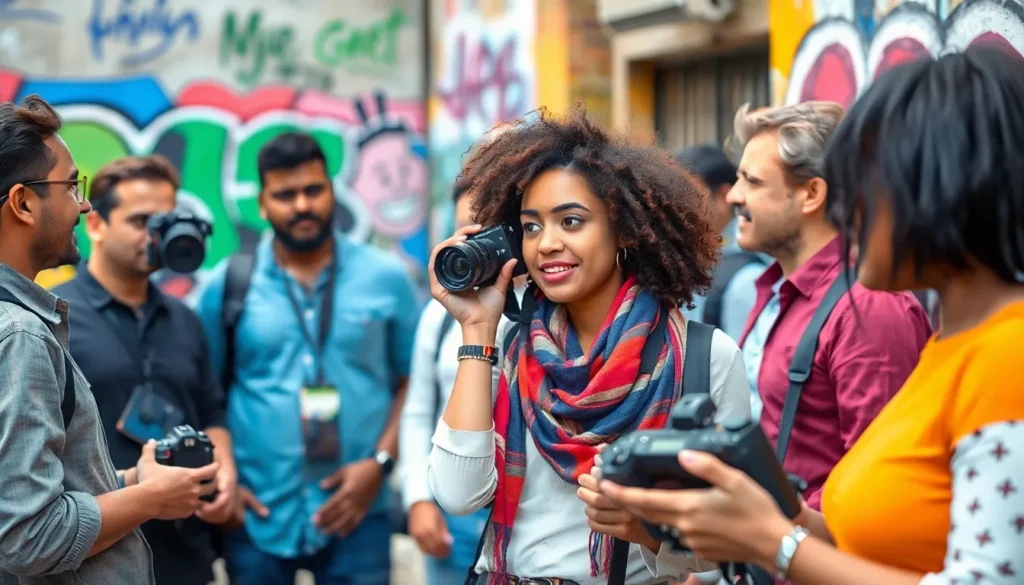In a world flooded with selfies and smartphone snapshots, photography collectives emerge as the secret sauce for creativity. These vibrant groups of passionate photographers come together, blending their unique perspectives into a visual feast that leaves viewers wanting more. Think of it as a potluck dinner where everyone brings their best dish—except in this case, it’s all about stunning images that tell stories and spark conversations.
Joining a photography collective isn’t just about sharing tips and tricks; it’s an invitation to explore the art of photography in a whole new light. Whether capturing the raw beauty of everyday life or pushing the boundaries of artistic expression, these collectives foster an environment where creativity thrives. So grab your camera, dust off those lenses, and get ready to dive into a world where collaboration meets inspiration, and every click tells a tale worth sharing.
Table of Contents
ToggleWhat Is a Photography Collective?
A photography collective consists of a group of photographers who collaborate and support each other in their artistic endeavors. These collectives enable members to share skills, ideas, and experiences. Photographers focus on a variety of genres, including portrait, landscape, and abstract photography, which enriches the collective’s offerings.
Members benefit from group critiques and collective projects, enhancing their growth and development as artists. Participation in a collective fosters a sense of community that can lead to potential exhibitions and networking opportunities. Additionally, photographers find inspiration in each other’s work, which often leads to innovative collaborations and new perspectives.
Photography collectives often organize workshops and events, providing valuable education for both members and the public. Furthermore, these gatherings allow for the exploration of emerging techniques and concepts. Collectives may also publish online galleries or zines, showcasing the diverse talents of their members.
A photography collective serves as a vehicle for creativity and connection. It acts as a platform for photographers to not only share their work but also to build relationships within the artistic community. The collaborative nature of these collectives drives innovation and helps photographers push boundaries in their art.
The History of Photography Collectives

Photography collectives trace their roots back to the late 19th and early 20th centuries. They emerged as groups of photographers who sought to challenge traditional artistic boundaries and share their craft. Early collectives provided a collaborative environment that encouraged experimentation with various techniques. These groups laid the groundwork for today’s vibrant photography communities.
Early Beginnings
The earliest photography collectives began forming in the 1850s. Groups like the Photo-Secession in the United States focused on promoting photography as an art form. Members organized exhibitions, elevated the medium’s status, and encouraged artistic freedom. This period witnessed the birth of collaborative projects, pushing photographers to innovate and refine their skills. By emphasizing peer support, these early collectives fostered a culture of sharing ideas and techniques.
Notable Examples Through Time
Significant collectives have emerged at various points in photography history. The Farm Security Administration (FSA) in the 1930s showcased work by photographers documenting social issues through a unified lens. In the 1960s, the New York-based group called “The New York School” presented contemporary themes, emphasizing personal expression. In recent years, collectives like Women Photograph advocate for diverse voices in photography, promoting inclusivity and representation. Each of these groups reflects the evolving landscape of photography and the enduring importance of collaboration in the art form.
Benefits of Joining a Photography Collective
Joining a photography collective enhances creative growth and community engagement. Members experience various advantages, from networking to sharing resources.
Networking Opportunities
Building relationships stands as a crucial advantage of photography collectives. Members connect with fellow photographers, industry professionals, and potential clients. Many collectives organize events like exhibitions or meetups, enabling photographers to showcase their work and gain exposure. Networking leads to collaborative projects, fostering creative partnerships. As photographers share experiences and knowledge, they enrich each other’s artistic journeys.
Shared Resources and Knowledge
Accessing shared resources proves beneficial for collective members. Photography collectives often offer workshops, equipment rentals, and studio space. Members share insights and tips, cultivating a culture of learning that accelerates skill development. Conversations about techniques and styles help photographers broaden their artistic perspectives. Knowledge exchange creates a supportive environment, enhancing creativity and technical proficiency within the group.
How to Start a Photography Collective
Starting a photography collective involves clear planning and collaboration among photographers. Establishing a common vision sets the foundation for success.
Defining Goals and Purpose
Define the collective’s goals and purpose early. Setting these parameters guides direction and motivation. Consider focusing on artistic development, community outreach, or specific genres. Aligning these elements fosters a clear identity. Members then share a common commitment to these shared objectives, which promotes cohesion and engagement. Develop plans to evaluate progress and adapt over time, ensuring the collective remains relevant and invigorating for all involved.
Finding Like-Minded Photographers
Finding like-minded photographers is essential for building a successful collective. Networking through social media platforms and local photography events provides access to potential members. Sharing interests in style and subject matter encourages unity. Promoting an open call for interested photographers can also attract diverse talents, enriching the collective’s dynamic. Gather input from interested individuals to enhance the group’s vision and culture. Assessing compatibility through group meetings can further ensure that the members connect and collaborate effectively.
Photography collectives represent a powerful movement in the creative landscape. They foster collaboration and innovation among photographers, allowing them to share their unique visions and experiences. By joining a collective, photographers not only enhance their skills but also build lasting connections within a supportive community.
These groups serve as a catalyst for artistic growth, pushing members to explore new techniques and perspectives. As the photography world continues to evolve, the role of collectives remains crucial in shaping the future of the art form. Embracing this collaborative spirit can lead to transformative experiences and inspiring work that resonates with audiences everywhere.



